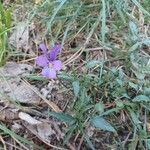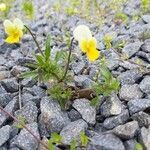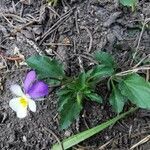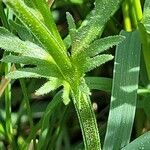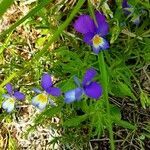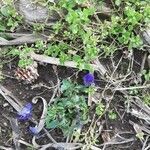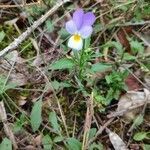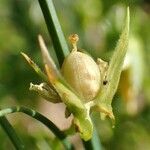Annual, with short-lived rosette; stems erect or ascending, with short hairs or glabrous, 7-30 cm tall. Lvs (1)-2-4 cm long, glabrous or with short hairs, with 3-7 crenations or blunt teeth each side. Basal lvs broadly ovate, truncately narrowed to long petiole; stipules short, linear-lobed. Stem lvs becoming narrow-elliptic, the uppermost cuneately narrowed to short petiole; stipules pinnatifid to palmatifid, 1/2-3/4 lf length, with leaflike terminal lobe and 3-7 linear lateral lobes. Peduncles erect, glabrous; bracts short, narrowly triangular. Fls 1.5-2.5 cm diam. Sepals narrowly triangular, acute, 5-8 mm long; appendages 2-3 mm long. Petals violet and/or yellow and cream, the upper > the upper sepals, the lowest with yellow or orange blotch and purple veins, the lowest and lateral bearded; spur 3-4 mm long, usually > the sepal appendages. Style geniculate at base, 1 mm long; stigma globose, with ligule on lower surface. Capsule ellipsoid, glabrous, 5-10 mm long. Seeds oblong, pale brown, 1.5 mm long.
Annual or biannual herb; stems simple or branched, prostrate to erect, angular, glabrous or pubescent. Leaves cauline; lamina ovate, oblong-lanceolate, lanceolate or narrowly elliptic, 15–28 mm long, 8–23 mm wide, apex obtuse to acute, margins crenate to serrate; petiole 10–33 mm long; stipules to 4 cm long, palmately or pinnately lobed, the mid-lobe usually entire, at least somewhat leaf-like. Flower-scapes 3–8 (–12) cm long; bracteoles just below flower. Sepals lanceolate, acute, 12–22 mm long, ciliate, with prominent basal appendages. Petals 14–19 mm long, longer than sepals; anterior petal spurred, creamy white with yellow-orange base with variable amounts of violet or purple, sometimes entirely violet or purple; upper petals blue to purple. Anthers ciliate. Style globose, with a distinct stylar flap. Capsule trigonous, 6–12 mm long. Seed 1.5–2 mm long, tan-coloured; aril very small.
Annual, biennial or perennial; rhizome short or none. Stems 10-40 cm, ascending or erect, usually branched. Leaves ovate-lanceolate to-elliptical, cuneate or subcordate at base, obtuse, crenate. Stipules deeply and pinnately lobed, terminal segment larger than the others, lanceolate, entire or crenate, leaf-like. Flowers c. 2-3 cm, violet, yellow or parti-coloured, very variable in colour and size; peduncle 3-10 cm, exceeding leaves. Sepals 7-14 by 2-5 mm, linear-lanceolate, acute, glabrous; appendage 3-5 mm, prominent. Petals obovate, 1-2 times as long as broad; spur 4-6 mm, variable up to twice as long as calycine appendages. Style 2-2½ mm, geniculate at the base, clavate distally with globose apex having prominent broad, anterior stigmatic beak. Capsule 8-14 mm, ellipsoid, glabrous.
Glabrous or hairy annual or short-lived perennial to 3 dm, often branched from the base; lvs all crenate, the lowest ones orbicular or cordate, the upper oblong to elliptic and basally cuneate; stipules foliaceous, laciniate to lyrate-pinnatifid, the middle lobe oblanceolate, distinctly toothed; internodes usually shorter than the lvs; fls 1.5–2.5 cm wide, the sep two-thirds as long as the pet; pet variously colored, the upper usually darker than the lower; style as in no. 27 [Viola rafinesquii Greene]; cleistogamous fls wanting; frs ellipsoid or oblong-ellipsoid, 6–10 mm; seeds dark brown; 2n=26. Native of Europe, extensively cult. and casually escaped in our range.
Erect annual, biennial or perennial herb, up to 300 mm tall. Lower leaves cordate to ovate, obtuse, crenate, upper leaves ovate to lanceolate, cuneate at base, crenate. Stipules deeply and pinnately lobed, terminal segment larger than the others, lanceolate, entire or crenate, leaf-like. Corolla exceeding calyx. Spur 3.0-6.5 mm, up to twice as long as calycine appendages. Flowers violet, yellow or parti-coloured.
A short lived perennial. It is often grown as an annual. It grows 10-35 cm high and spreads 15-40 cm wide. The stem is branched. There are large, deeply divided stipules. The leaves are oval and pointed or lance shaped. They have shallow lobes or teeth. The flowers can have several colours.
